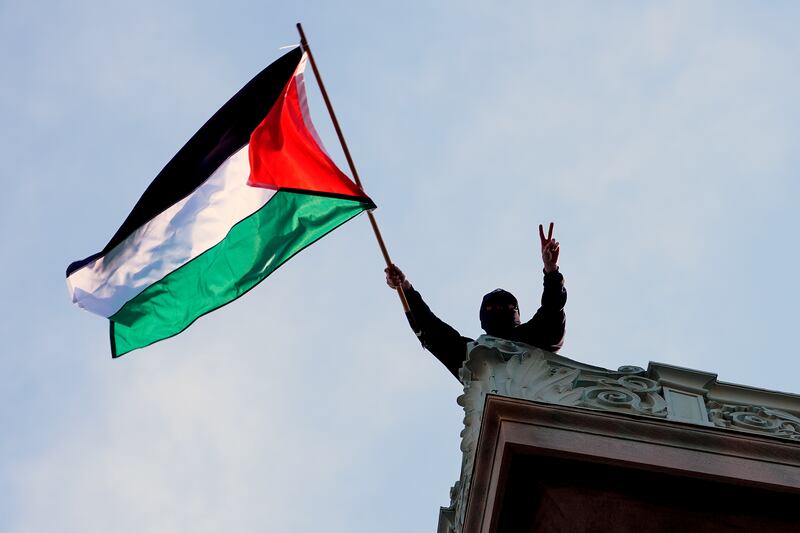In May of last year, the Utah Board of Higher Education passed a “Resolution on Freedom of Expression,” in which it directed institutions within the Utah System of Higher Education to implement broad principles of free expression through “specific policies, practices, and procedures.”
The first principle was that an institution should maintain institutional neutrality — that it “must refrain from taking public positions on political, social, or unsettled issues.” Neutrality would then allow the institution to act as a forum for faculty, students and staff to express “conflicting, controversial, or unpopular viewpoints.”
The past couple of weeks have provided test cases for student expression, as close to home as the University of Utah’s campus, but most notably on Columbia University’s campus, where students overtook and barricaded themselves in a building in connection with their protest. In many respects, the students are fulfilling the role that institutional neutrality creates as they protest their university’s indirect funding of Israel through investment. This and any other speech should be protected, even if some find it offensive or hateful. Unfortunately, there appears to be a fundamental misunderstanding among many of these students with respect to what the First Amendment protects and what it does not protect.
As an initial matter, the First Amendment applies only to public entities. In a university or college setting, public institutions must accommodate, without discriminating based on its content, space for expression to take place. Private institutions of higher education, though most by self-imposed policy claim to provide First Amendment-equivalent type protections of expression, are not constitutionally bound to do so. As applied, public institutions, like the University of Utah, are beholden to the First Amendment, while private institutions, like Columbia University, are not, though they may aspire to that ideal.
The First Amendment’s protections in this context are not without limits. Universities can impose reasonable limitations on the time, place and manner of expression. What’s more, the First Amendment’s freedom of expression does not condone violence, true threats of violence, incitement to lawless action or harassment, which often occurs when individuals are targeted on the basis of sex, race, color or national origin. Bound up within all of this, students may not break the law in connection with their expression.
Student protesters seem prone to take the nuanced analysis around expression and its limits and distill it down to whether it is peaceful or not; and if so, it should not be curtailed. To be sure, peaceful protests are ideal and are often more effective in persuading bystanders. They also create a university environment in which members feel free to communicate their ideas and respectfully disagree with one another. Peaceful protests are often necessary to stay within the bounds of constitutionally protected expression. But even a peaceful demonstration will not be allowed if it goes beyond reasonable time, place and manner restrictions.
The trending apparatus for protest, including at the University of Utah, is an encampment with tents. Even if the encampment is set up in a space set aside for demonstrations on campus, its perpetual duration pushes up against a university’s reasonable time and manner restrictions designed to protect public safety and ensure campus order.
The appeal of an encampment is not hard to see. It creates a community. It creates solidarity. Its ongoing nature makes it difficult to ignore. After all, if protests occurred and disbanded each day in accordance with the university’s reasonable time, place and manner restrictions, there would likely be no issue. But that is the point: There would be no issue. There would be less or no news coverage. Social media updates would be a bore. Increased public awareness of the issue would be minimal. An encampment is an act of civil disobedience that does exactly what it is intended to do: It puts protestors and their cause in the limelight.
But students complaining when they are arrested feels a lot like eating cake and then complaining there is none left. Students have to understand that the First Amendment protects their freedom of expression in unique and important ways, more so than can be found in almost any other country on Earth. But when they make the choice, in hopes of bringing more attention to their cause, to go beyond what the First Amendment protects, up to and including acts of civil disobedience that break the law, they must be prepared to face the consequences. This is a cost-benefit analysis: Is the benefit of more public notoriety for your cause worth the potential criminal and academic sanctions that may follow?
Jane Fonda, speaking to her work as an environmental activist, once quipped that “it feels good” to be arrested for civil disobedience. This is easy for a celebrity without concerns over future employment or current academic standing to say. It may not feel as good for students who are probably quite concerned about both of those things.
Eric Smith is associate dean and professor of taxation in the Goddard School of Business & Economics at Weber State University. He is also an adjunct professor of law at the University of Utah’s S.J. Quinney College of Law. The views expressed in this opinion article by the author are his alone and don’t necessarily reflect those of his employers or the Deseret News.

